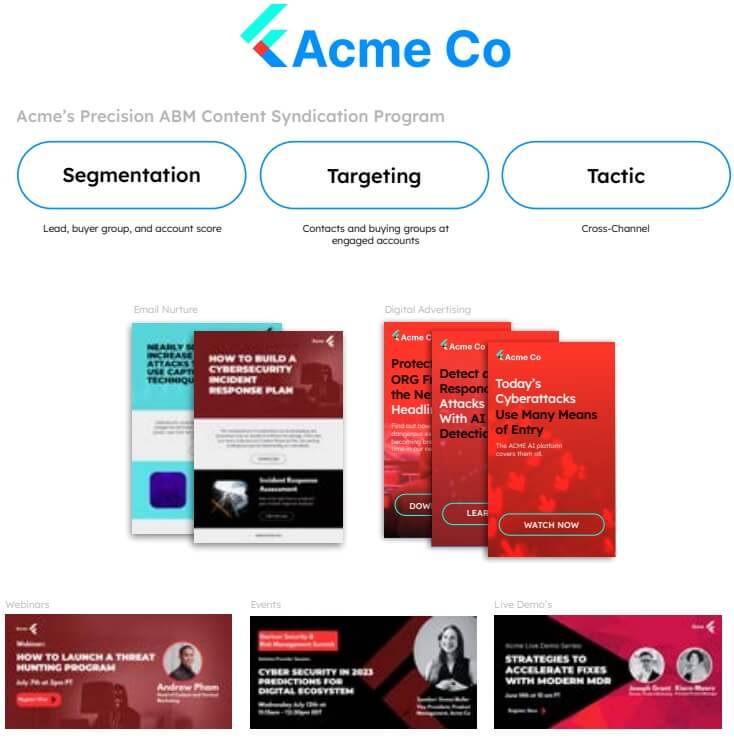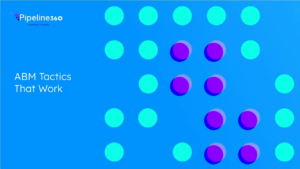As pressure mounts to show ROI, organisations that will succeed are those taking a cross-channel, holistic approach to account-based marketing (ABM).
ABM tactics that deliver predictable pipeline
Welcome to “ABM tactics that work,” your comprehensive guide to mastering Account-Based Marketing (ABM) strategies that drive remarkable results. In this guide, we will delve into the world of ABM and explore a diverse array of tactics that have proven to be highly effective in engaging and converting target accounts.
From precision ABM to vertical marketing ABM, named account ABM to large account ABM, we will uncover the secrets to crafting tailored approaches for different account types.
Additionally, we will unveil the power of cross-channel marketing strategies, the significance of intent data, and the art of creating personalised and relevant buying experiences for entire buying groups within in-market accounts. Embrace the power of ABM and discover the tactics that will elevate your B2B marketing game to new heights. Let’s get started!
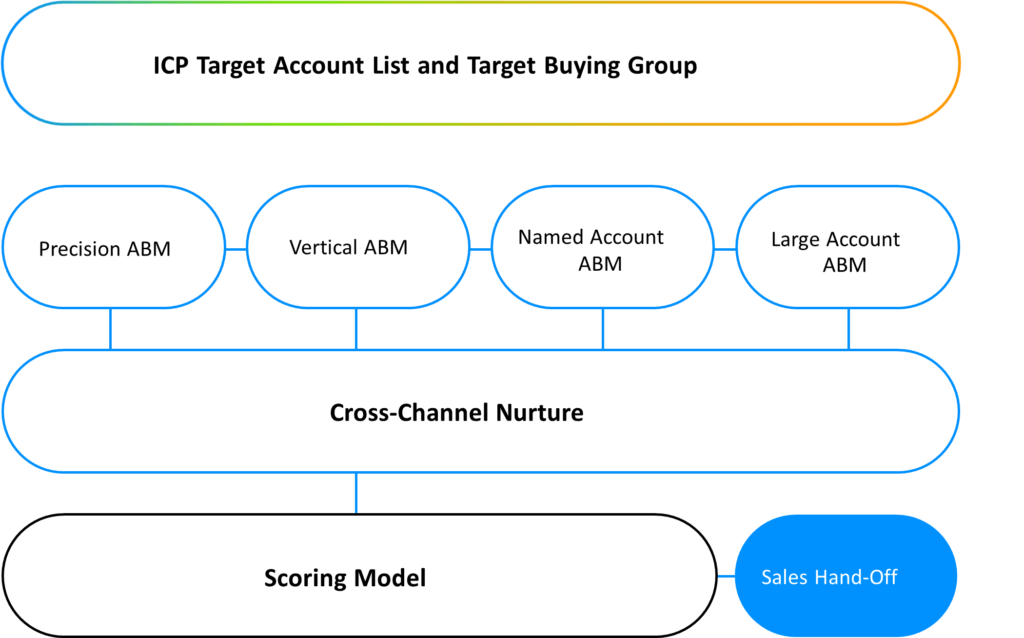
Meet Acme Co.

In this guide, we’ll explore various ABM tactics using an imaginary B2B enterprise SaaS company called Acme Co. They have adopted a unified approach known as Precision Demand Marketing (PDM) that merges ABM and demand marketing strategies.
Acme Co.’s PDM method centers on ideal customer profile (ICP) accounts, engaging buying groups within ICP accounts, and delivering personalised, relevant cross-channel journeys for different buyer groups.
Throughout this guide, we’ll use Acme Co. as an example to demonstrate the implementation of each ABM tactic in creating a predictable pipeline for their cybersecurity platform SaaS product.
About Acme Co:
- Company Size: 1,200 employees
- Location: United Kingdom
- Industry: Cybersecurity Technology
- Annual Revenue: £250 million
Precision ABM
Precision ABM is a strategic approach that combines precise ABM targeting with the scale of classic demand tactics like content syndication. By doing so, it generates a top-of-funnel pipeline that includes only ideal customer profile (ICP) leads.
Precision ABM checklist:
- Precision ABM requires basic account profile data, such as account name, industry, and geography. It also uses data on target personas, buyer needs, and triggers.
- Since precision ABM covers a broad set of target accounts, existing marketing content aimed at typical buyer personas can be used.
- No special channels are needed, and existing campaign delivery channels may be used.
Acme Co. uses precision ABM to acquire buying group members from key accounts in the UK. They employ precision ABM content syndication programs targeting their ICP accounts, segmenting each program to address specific job functions with personalised content at the buyer persona level.
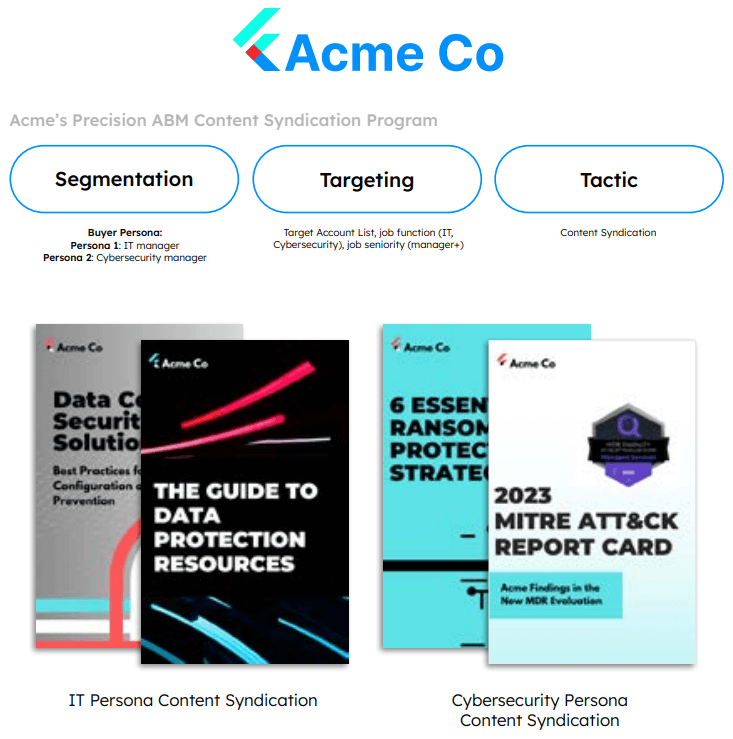
Vertical marketing ABM
Vertical, or industry, ABM, is based on the segmentation of target accounts by industry or sub-industry categories. Vertical Marketing ABM relies on specialised marketing assets to establish credibility and highlight company capabilities within specific vertical markets.
Vertical ABM checklist:
- Vertical ABM requires the same basic account profile data that precision ABM does. It also requires insights on industry trends and preferred information sources, industry-specific terminology, and first- or third-party intent data.
- Content needs to feature messaging and information relevant to the target industry or sub-industry. General marketing content must often be “customised” with the addition of relevant terms and imagery from specific vertical markets.
- Channels should be selected based on preferred information sources for the industry. Account-targeted advertising is an effective tactic for this ABM approach. In addition, nurture streams should also feature vertical market messaging and content.
Acme Co. analyses their customer data and identifies financial services as a highly profitable vertical. They strategically target this segment with customised content and personalised ads, while excluding them from other media programs to ensure relevance.

Named-account ABM
Named-account ABM is based on the concept of segmenting named target accounts into cohorts of accounts based on shared attributes. It is not simply segmenting accounts by sales territories or sales rep ownership. Shared attributes can be based on attributes such as similar technology stacks, company size (e.g., revenue or employee base), geography, solution use cases, new vs. existing customers, and other relevant criteria.
Named-Account ABM checklist:
- Named-account ABM requires the same basic data that precision ABM does. It also requires insights on specific internal account plans, pipeline data, firmographic and technographic data, target account company news and insights (e.g., leadership changes, acquisitions, and other events that could trigger a purchase need), and first- and third-party intent data.
- Content needs to feature messaging and information relevant to the segmentation attributes used to group the named accounts. In addition, a degree of content personalisation is highly desirable (e.g., personalised headlines and key content modules, use of dual company logos, etc.) to drive greater engagement.
- Channels should be selected based on knowledge of the account segments. Existing campaign delivery channels may be used, but investment in account-specific channels may be desired (e.g., account-specific newsletters or microsites). Sales intelligence should be used to customise offer timing and to personalise nurture streams.
Acme Co. leverages account insights from technographic, firmographic, and intent data to create an account cohort. The selected accounts are those actively researching cybersecurity products, utilising Amazon Web Services, and generating over £50M in annual revenue.
To engage this cohort effectively, Acme Co. tailors display advertising and content syndication, ensuring the exclusion and suppression of these accounts from other programs to deliver only the most relevant messaging.
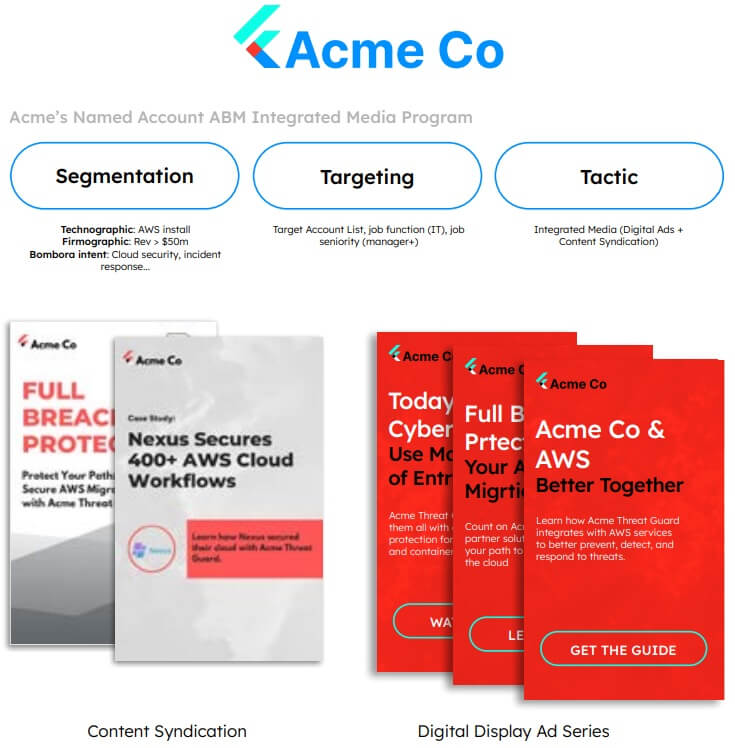
Large-account ABM
Large-account, or 1:1 ABM, is the strategy of marketing to individual accounts that are typically both large in size and of significant importance to the company. These accounts are well known, have specific needs, and have dedicated sales resources supporting them.
Large-Account ABM checklist:
- Large-account ABM requires the same data that all of the prior ABM approaches do. It also requires information on competition, contract status, customer feedback, unique account protocols (e.g., the “ways of doing business”), and any desired account business value outcomes.
- All messaging and content should be customised to the account and include custom value propositions for specific opportunities, account-specific terminology, and ideally use co-branded and account-specific imagery.
- Account-specific channels should be used, such as personally delivered emails to key account contacts, presentations at regular meetings with the account team, microsites, account’s intranet or Wiki pages, etc. The account lead or manager should be consulted to coordinate offer timing and communication cadences.
Alcott Labs, a strategic account for Acme Co., presents significant expansion revenue potential if Acme Co. can further penetrate its corporate structure. Acme Co.’s global ABM team creates a suite of custom assets specifically aligned with Alcott Labs’ account goals and buying needs. Using sales intelligence, firmographic data, buying group mapping, and comprehensive account planning, Acme Co. strategically targets Alcott Labs’ subsidiaries and divisions with a comprehensive large-account
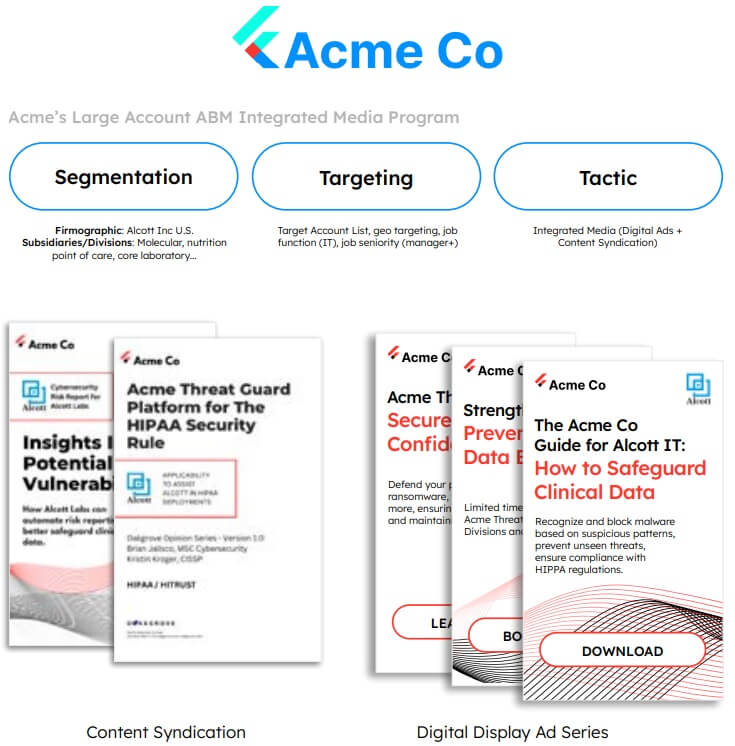
Cross-channel nurture
In today’s buyer landscape, purchasing decisions are increasingly made by buyer groups, not individuals, who engage with sales only after narrowing down their list of potential vendors. To address the needs of buying groups and provide relevant customer journeys, a cross-channel nurture program comes into play.
The cross-channel nurturing approach supports various ABM strategies (precision ABM, vertical ABM, and named-account ABM), by driving increased account engagement and activity. It elevates the engagement scores of individual contacts, buying groups, and accounts, preparing them for a seamless hand-off to the sales team. Note that a cross-channel nurturing approach should only be used for largeaccount ABM with the approval of the account lead or manager.
Acme Co. leverages a cross-channel nurture program to maintain engagement with contacts and accounts that haven’t yet met the scoring requirements from their ABM tactics, ensuring they are fully nurtured before sales hand-off.
